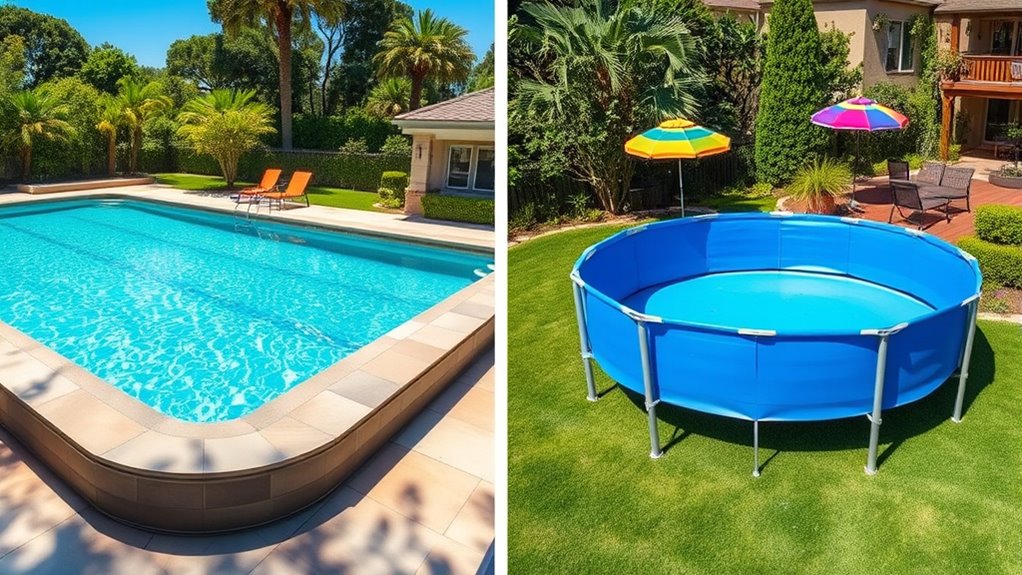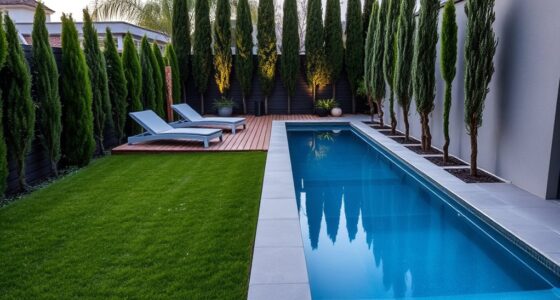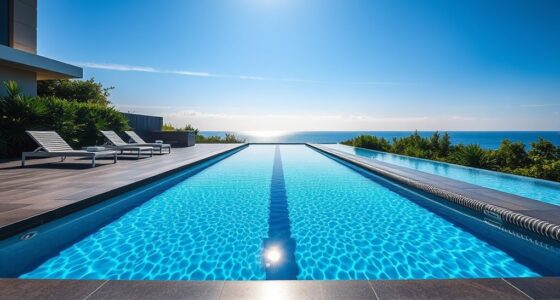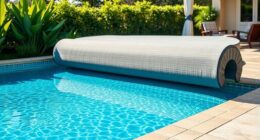Inground lap pools offer custom designs, durable decks, and a sleek look, but they come with higher initial costs and maintenance efforts. Above-ground pools are more budget-friendly, faster to install, and easier to care for, making them great for casual use. However, they may lack the design flexibility and long-term durability of inground options. To find out which suits your space and lifestyle best, explore the detailed advantages and disadvantages that follow.
Key Takeaways
- Inground lap pools offer customized designs and durable decks, ideal for long-term, high-end installations.
- Above-ground lap pools are more budget-friendly, quicker to install, and easier to maintain.
- Inground pools typically require higher initial costs and ongoing maintenance, while above-ground pools are more economical overall.
- Durable, custom decks in inground pools enhance aesthetics and longevity but increase upfront expenses.
- The choice depends on budget, maintenance willingness, and desired customization for fitness or leisure needs.

Are you torn between choosing an inground or above-ground pool for your backyard? Making this decision depends on several factors, including how you plan to use your pool, your budget, and the maintenance involved. If you’re considering a lap pool, it’s especially important to weigh the pros and cons carefully to find the best fit for your space and lifestyle.
Choosing between inground and above-ground pools depends on usage, budget, and maintenance needs.
When it comes to deck material, the options can greatly influence your pool’s overall look and functionality. Inground pools often feature custom decks made from concrete, stone, or wood, which can be tailored to your design preferences. These materials tend to be more durable and provide a seamless changeover from your yard to the pool area. In contrast, above-ground pools typically come with simpler, pre-fabricated decks or platforms, often made from pressure-treated wood or composite materials. While these are usually easier and quicker to install, they may require more frequent repairs or replacements over time, increasing the overall maintenance costs. If you prefer a more polished, integrated appearance, an inground pool with a well-chosen deck material might be the better option. However, keep in mind that the initial investment in deck material and installation can be higher compared to above-ground setups.
Maintenance costs are another vital factor. Inground pools generally demand higher ongoing expenses because of their complex structure and the need for regular cleaning, chemical balancing, and occasional repairs. The pool’s filtration system and liner, for example, may need more attention over the years, adding to your maintenance budget. Above-ground pools are usually less expensive to maintain since they are smaller, simpler, and easier to access for cleaning and repairs. Their equipment is often more straightforward, and replacement parts tend to be more affordable. Nevertheless, if you opt for an inground pool, investing in quality deck material and a reliable maintenance routine can extend the lifespan of your pool and reduce long-term costs. Additionally, choosing durable deck material can help lower maintenance needs and improve longevity.
Ultimately, choosing between an inground and above-ground lap pool comes down to your priorities. If you value customization, durability, and a sleek appearance, an inground pool with a durable deck material might be worth the extra investment. If you prefer a quick, budget-friendly setup with lower ongoing costs, an above-ground pool could be the right choice. Consider how much time and money you’re willing to dedicate to maintenance, as this can influence which option suits your lifestyle best. Whichever you choose, understanding the implications of deck material and maintenance costs will help you make an informed decision that brings you years of enjoyment.
Frequently Asked Questions
How Long Does It Typically Take to Install Each Type?
The installation timeline varies based on the pool type. An above-ground lap pool usually takes about 1 to 3 days, thanks to simpler construction. In contrast, inground pools typically require 4 to 12 weeks, depending on factors like site preparation and permits. The construction duration for inground pools is longer because of excavation, foundation work, and more extensive plumbing. Planning ahead helps make sure your pool is ready for use as soon as possible.
Are Above-Ground Pools More Energy-Efficient Than Inground Pools?
You’ll find that above-ground pools are generally more energy-efficient than inground pools because they have better insulation efficiency, reducing energy consumption for heating. Since they’re easier to cover and insulate, they lose less heat, saving you money on energy bills. In contrast, inground pools often require more energy to maintain temperature due to less insulation. So, if energy efficiency matters, above-ground pools might be the smarter choice.
What Maintenance Differences Exist Between the Two Pool Types?
You’ll find that maintenance differs between pool types. With above-ground pools, you generally do easier pool cleaning since debris is more visible and accessible. Chemical maintenance tends to be simpler because the smaller volume means chemicals balance faster. Inground pools require more effort for pool cleaning, especially in hard-to-reach areas, and you’ll often need more chemicals to maintain proper water chemistry. Overall, above-ground pools make routine upkeep a bit more manageable.
Can Either Pool Type Be Customized With Features Like Waterfalls?
You can customize either pool type with features like waterfalls, thanks to their design flexibility. Pool accessories are easily added to enhance aesthetics and functionality, whether you choose an inground or above-ground lap pool. Both options support unique design elements, so you can create a personalized swimming experience. Just keep in mind that inground pools often offer more seamless integration for elaborate features, but above-ground pools can still be customized effectively.
What Are the Resale Value Implications for Each Pool Type?
Did you know that in-ground pools can boost property value by up to 8%? When considering resale value impact, in-ground pools typically increase your home’s worth more than above-ground options. They’re seen as a permanent upgrade, making your property more attractive to buyers. Above-ground pools, however, tend to have a lower resale value impact, serving more as temporary features. Think about your long-term plans before choosing one for better property value increase.
Conclusion
Choosing between an inground and above-ground lap pool depends on your budget, space, and long-term goals. For example, if you prioritize durability and a sleek look, an inground pool might be best. But if you want flexibility and lower costs, an above-ground option could work well. Consider your lifestyle and maintenance preferences. Ultimately, selecting the right pool type will help you enjoy swimming for years to come, just like many homeowners who’ve made the perfect choice for their backyard.









